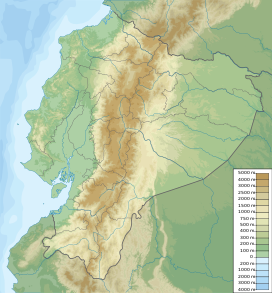Sumaco
| Sumaco | |
|---|---|
 Sumaco Volcano. | |
| Highest point | |
| Elevation | 3,990 m (13,090 ft)[1] |
| Coordinates | 00°32′17″S 77°37′33″W / 0.53806°S 77.62583°W[1] |
| Geography | |
| Geology | |
| Mountain type | Stratovolcano |
| Last eruption | 1895 ± 30 years |
Sumaco is a symmetrical, isolated stratovolcano, that is set off from the main Ecuador volcanic axis. Its rocks are very distinct from those from most Andean volcanoes because of its lack of andesitic composition, in favour of basanite and phonolitic rock. Sumaco is heavily forested and contains a small cone in its broad summit crater. An historical eruption occurred around 1895 (± 30 years).[1]
Ecology[edit]
Sumaco is isolated from the Cordillera Oriental by the lowland valley of the Cosanga and Quijos Rivers.[2] There are more than 6000 species of vascular plants, including more than 90 endemic species.[3] There are also a number of endemic animals, including toad Osornophryne sumacoensis only known from the eastern slopes of Sumaco,[4][5] and robber frog Pristimantis ernesti only known from the summit of Sumaco.[6][7]
References[edit]
- ^ a b c "Sumaco". Global Volcanism Program. Smithsonian Institution. Retrieved 2012-01-09.
- ^ Lee, T. E.; Burneo, S. F.; Marchán, M. R.; Roussos, S. A. & Vizcarra-Váscomez, R. S. (2008). "The mammals of the temperate forests of Volcán Sumaco, Ecuador" (PDF). Occasional Papers, Museum of Texas Tech University. 276: 1–10.
- ^ "Parque nacional Sumaco". Ministerio del Ambiente. Retrieved 8 February 2015.
- ^ Coloma, L.A.; Ron, S.; Cisneros-Heredia, D. & Almandáriz, A. (2004). "Osornophryne sumacoensis". IUCN Red List of Threatened Species. 2004: e.T54859A11203411. doi:10.2305/IUCN.UK.2004.RLTS.T54859A11203411.en. Retrieved 10 January 2018.
- ^ Coloma, L. A.; Páez-Moscoso, D.; Frenkel, C.; Félix-Novoa, C. & Quiguango-Ubillús, A. (2014). "Osornophryne sumacoensis". Ron, S. R., Guayasamin, J. M., Yanez-Muñoz, M. H., Merino-Viteri, A., Ortiz, D. A. y Nicolalde, D. A. 2014. AmphibiaWebEcuador. Version 2014.0. Museo de Zoología, Pontificia Universidad Católica del Ecuador (QCAZ). Archived from the original on 3 February 2015. Retrieved 8 February 2015.
- ^ Lynch, J.; Coloma, L.A. & Ron, S. (2004). "Pristimantis ernesti". IUCN Red List of Threatened Species. 2004: e.T56585A11488039. doi:10.2305/IUCN.UK.2004.RLTS.T56585A11488039.en. Retrieved 10 January 2018.
- ^ Frenkel, C.; Yánez-Muñoz, M. H.; Guayasamín, J. M.; Varela-Jaramillo, A. & Ron, S. R. (2013). "Pristimantis ernesti" (AmphibiaWebEcuador. Version 2014.0 ed.). Museo de Zoología, Pontificia Universidad Católica del Ecuador (QCAZ). Archived from the original on 2015-02-11. Retrieved 11 February 2015.

